

| Chat occurrences at Eakring and Kersall 1998-2012 | |||
| The number of records produced by all four chat featured on this page, makes up just a fraction of the overall Nottinghamshire picture and there are undoubtably many which go unrecorded from rarely visited or as yet, unknown regular stop-over sites. This situation can certainly be applied to Redstart here prior to regular coverage and is without doubt, also attributable to Wheatear records as well. | |||
| ... | |||
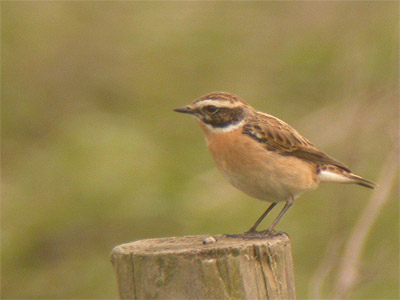 |
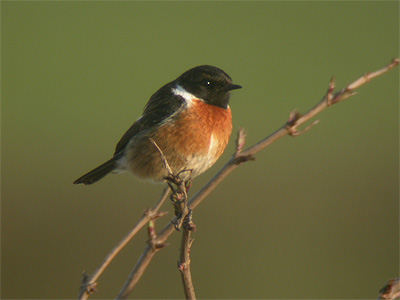 |
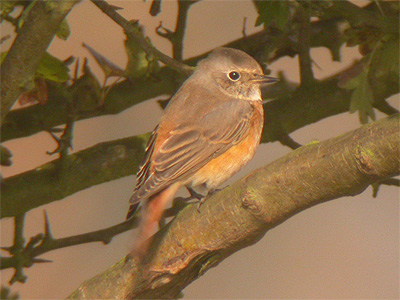 |
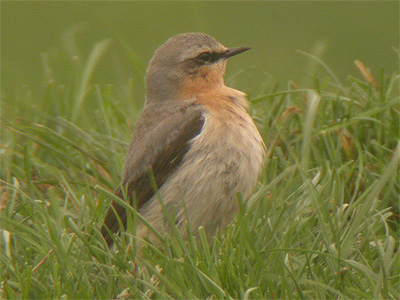 |
| ... | |||
| Scattered Hawthorn scrub on Penny Pasture Common (one section of the Nottinghamshire Wildlife Trust's Eakring Meadows Nature Reserve) is a prime example of this, now having the proven ability to regularly attract migrant Redstart and Whinchat during the Autumn. Likewise, any bare/open field has the ability to attract migrant Wheatears. Autumn Chat records are frequently an indication that the East coast has experienced an arrival of Continental migrants (coinciding with) or prior to their occurrence at Eakring. This is dealt with in more detail on the East-coast falls page, elsewhere on this website. | |||
| Redstart Phoenicurus phoenicurus |
||
| 56 individual birds | ||
| ... | ||
| The majority of Redstart
records have come during the Autumn, with eight Spring
records now; two in 2001 and 2004, one in 2005 and three
in 2007. Quite why the species is so uncommon here in
Spring, is hard to determine - especially considering
chats almost certainly migrate in mixed groups/flocks.
Most of the Spring records have however, coincided with a good arrival of Wheatears, but Redstarts have only been found within 500m of these on one occasion, which rather disproves the mixed flock theory. The creation of several large paddocks on the outskirts of Eakring village in 2003, attracted good numbers of Wheatear during a period of concentrated passage the following Spring, where the wire fence and hedgerow running around it's boundary, did attract a male on one occasion. All of the Spring birds have been found favouring hedgerow habitats in quite open, agricultural situations. With the possible exception of Bennerley Marsh, a total of 35 Autumn records probably now make this the most productive area in the county for migrant Redstarts. Prior to 1998, there are no available records from the area. |
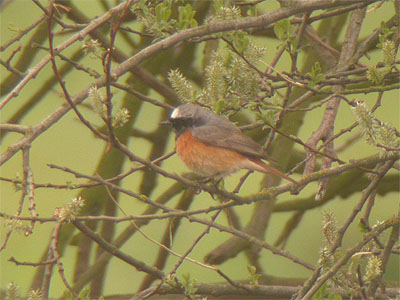 |
|
| ... | ||
| All records
(both Spring and Autumn) have come from Hawthorn scrub or
hedgerows, and all but two have occurred from the three
main sites for the species. These records relate to males
near Kersall in Spring 2001 and 2007. Spring limits: Dates provided by the area's nine Spring migrants are April 10-May 1st. Autumn limits: Redstarts have produced the greatest inclusive dates, ranging from July 9th-October 11th. The single July date is very early. Autumn birds have a greater tendency to remain in the area longer (often several days) than the rest of the family's representatives. Quite why is unknown. One theory is that many of the records here, involve genuine long-distance (Scandinavian) migrants? This is certainly an interesting view and is supported by their occurrences here during or after large-scale arrivals on the UK's East-coast. The question then arises as to why Whinchats (a species with a similar ratio of Eakring records/East-coast arrivals) rarely linger? Evidence gathered from the ageing of migrant Whinchats here, show that there is a considerable turn-over of birds, even on a daily basis. |
||
| Monthly occurrences of Redstart at Eakring 1998 - 2012 | |||||||||||||||||||||||||||||||||||||||||||||||||||||||||||||||||||||||||||||||||||||||||||||||||||||||||||||||||||||||||||||||||||||||||||||||||||||||||||||||||||||||||||||||||||||||||||||||||||||||||||||||||||||||||||||||||||||||||||||||||||||||||||||||
| ... | |||||||||||||||||||||||||||||||||||||||||||||||||||||||||||||||||||||||||||||||||||||||||||||||||||||||||||||||||||||||||||||||||||||||||||||||||||||||||||||||||||||||||||||||||||||||||||||||||||||||||||||||||||||||||||||||||||||||||||||||||||||||||||||||
|
| Whinchat Saxicola rubetra |
||
| 122 individual birds | ||
| ... | ||
| Whinchats show a distinct
preference here for Penny Pasture Common and Eakring
Flash. Both providing different habitats, with the only
similarity being that both sites contain water.
Vegetation growth is very different at either site. At
Eakring Flash, birds are predominantly attracted to
growing crops adjacent to the site such as Bean and
Sugar-beet, in the absence of more favoured Hawthorn
scrub and fence-posts found at Penny Pasture Common.
Whinchats certainly associate with Wheatears on
migration. Evidence of this coming from the numerous
times, both have shared the same feeding site/field, also
arriving simultaneously like most members of this group
about two hours after first light. There are few records
of birds arriving after mid-day, but it does occur. Spring limits: April 22-27th and May 11-14th. Both arrival periods are quite restricted. Autumn limits: July 21-October 1st, with a general peak coming between August 28-September 14th. |
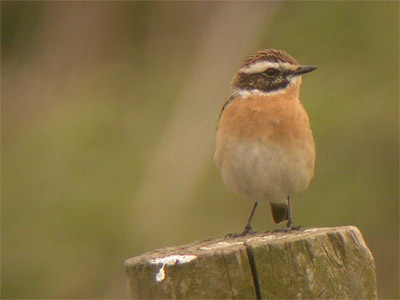 |
| Monthly occurrences of Whinchat at Eakring 1998 - 2012 | |||||||||||||||||||||||||||||||||||||||||||||||||||||||||||||||||||||||||||||||||||||||||||||||||||||||||||||||||||||||||||||||||||||||||||||||||||||||||||||||||||||||||||||||||||||||||||||||||||||||||||||||||||||||||||||||||||||||||||||||||||||||||||||||
| ... | |||||||||||||||||||||||||||||||||||||||||||||||||||||||||||||||||||||||||||||||||||||||||||||||||||||||||||||||||||||||||||||||||||||||||||||||||||||||||||||||||||||||||||||||||||||||||||||||||||||||||||||||||||||||||||||||||||||||||||||||||||||||||||||||
|
|||||||||||||||||||||||||||||||||||||||||||||||||||||||||||||||||||||||||||||||||||||||||||||||||||||||||||||||||||||||||||||||||||||||||||||||||||||||||||||||||||||||||||||||||||||||||||||||||||||||||||||||||||||||||||||||||||||||||||||||||||||||||||||||
| Good numbers arrived during early September 1998, when various groups included up to six on one occasion. A clear peak in the number of arrivals has since been shown to occur around this time, with no records before the middle of August prior to 2004 when the first returning migrant arrived at Eakring Flash in July. There are few records from other sites away from Eakring Flash and Penny Pasture Common. Most of these involve hedgerow birds at Tug Bridge Farm. One very unusual record came in Spring 2002, when a bird frequented an Ivy-covered tree near Kersall. |
| Stonechat Saxicola torquata
|
| 52 individual birds |
| ... |
| Stonechats first appeared
here in October 1999 and have since become annual
visitors, producing records in both early Spring and
Autumn. During October 2001, there was a good Stonechat
influx nationally and this was also reflected here, as
are so many species' influxes. Most birds were brief,
staying for either one or two days. They also show a preference for rank vegetation. Consequently Eakring Flash and Penny Pasture Common have provided the bulk of the records, but birds have also been found perched on roadside hedgerows within pure farmland habitat in the Red Hill area and around the Tug Bridge Farm/Church Hill areas. Autumn Stonechat records had been concentrated to within a ten-day period in October until the occurence of the area's earliest ever arrival on September 20th 2002. Spring limits: February 21-March 29th with a peak date occurring on March 11-12th (five records) On April 23rd 2008, a Stonechat showing many characteristics of the race rubicola was present at Eakring Flash. |
 |
|
| ... | ||
| Autumn
limits: September 20-October 29th Winter records: There is just one record of a bird on December 30th 2000 Recent years have seen an up-turn in Autumn records and it was only recently that regular Stonechat sites became identified. Spring migrants are more generally attracted to Eakring Flash, a site which has the habitat to (potentially) hold over-wintering birds, whilst many Autumn records have come from Penny Pasture Common at Eakring Meadows. |
|||||||||||||||||||||||||||||||||||||||||||||||||||||||||||||||||||||||||||||||||||||||||||||||||||||||||||||||||||||||||||||||||||||||||||||||||||||||||||||||||||||||||||||||||||||||||||||||||||||||||||||||||||||||||||||||||||||||||||||||||||||||||||||||||
| Monthly occurrences of Stonechat at Eakring 1998 - 2012 | |||||||||||||||||||||||||||||||||||||||||||||||||||||||||||||||||||||||||||||||||||||||||||||||||||||||||||||||||||||||||||||||||||||||||||||||||||||||||||||||||||||||||||||||||||||||||||||||||||||||||||||||||||||||||||||||||||||||||||||||||||||||||||||||||
| ... | |||||||||||||||||||||||||||||||||||||||||||||||||||||||||||||||||||||||||||||||||||||||||||||||||||||||||||||||||||||||||||||||||||||||||||||||||||||||||||||||||||||||||||||||||||||||||||||||||||||||||||||||||||||||||||||||||||||||||||||||||||||||||||||||||
|
|||||||||||||||||||||||||||||||||||||||||||||||||||||||||||||||||||||||||||||||||||||||||||||||||||||||||||||||||||||||||||||||||||||||||||||||||||||||||||||||||||||||||||||||||||||||||||||||||||||||||||||||||||||||||||||||||||||||||||||||||||||||||||||||||
| Wheatear Oenanthe oenanthe oenanthe |
| 247 individual birds |
| ... |
| More common here as a
Spring passage migrant, Wheatears prefer a more open
habitat. Any bare field will produce records here and
many records are reliant on the availability of fields
assigned for growing Sugar-beet or open 1st year
set-aside fields. Favourite migrant sites include both
Tug Bridge and Eakring Field Farms and Church Hill.
Eakring Meadows is rarely visited. Spring limits: March 22nd-May 20th. Wheatears tend to show two main passage/arrival periods from March 22-30th and April 22-29th. Birds of the Greenland race have produced arrival dates from April 26-May 20th (12 records) Autumn limits: August 13-October 13th. Birds belonging to the Greenland race have provided inclusive dates of September 19-October 17th. |
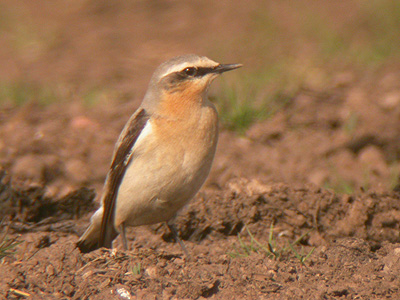 |
|
| ... | ||
| Monthly occurrences of Wheatear at Eakring 1998 - 2012 Greenland Wheatear records are included in all Wheatear totals | |||||||||||||||||||||||||||||||||||||||||||||||||||||||||||||||||||||||||||||||||||||||||||||||||||||||||||||||||||||||||||||||||||||||||||||||||||||||||||||||||||||||||||||||||||||||||||||||||||||||||||||||||||||||||||||||||||||||||||||||||||||||||||||||||
| ... | |||||||||||||||||||||||||||||||||||||||||||||||||||||||||||||||||||||||||||||||||||||||||||||||||||||||||||||||||||||||||||||||||||||||||||||||||||||||||||||||||||||||||||||||||||||||||||||||||||||||||||||||||||||||||||||||||||||||||||||||||||||||||||||||||
|
|||||||||||||||||||||||||||||||||||||||||||||||||||||||||||||||||||||||||||||||||||||||||||||||||||||||||||||||||||||||||||||||||||||||||||||||||||||||||||||||||||||||||||||||||||||||||||||||||||||||||||||||||||||||||||||||||||||||||||||||||||||||||||||||||
| Greenland
Wheatear
Oenanthe oenanthe leuchorhoa Nottinghamshire records of this larger sub-species are surprisingly rare. This is almost certainly due to them either being overlooked, or observer inexperience in identification of this race. There have been 14 records to date, with passage birds generally being recorded later during both migration periods. Note: All records listed as Eakring Meadows, refer to Penny Pasture Common. The occurrence tables used on this page are updated versions of those currently available on the Species migration pages. |
|||||||||||||||||||||||||||||||||||||||||||||||||||||||||||||||||||||||||||||||||||||||||||||||||||||||||||||||||||||||||||||||||||||||||||||||||||||||||||||||||||||||||||||||||||||||||||||||||||||||||||||||||||||||||||||||||||||||||||||||||||||||||||||||||